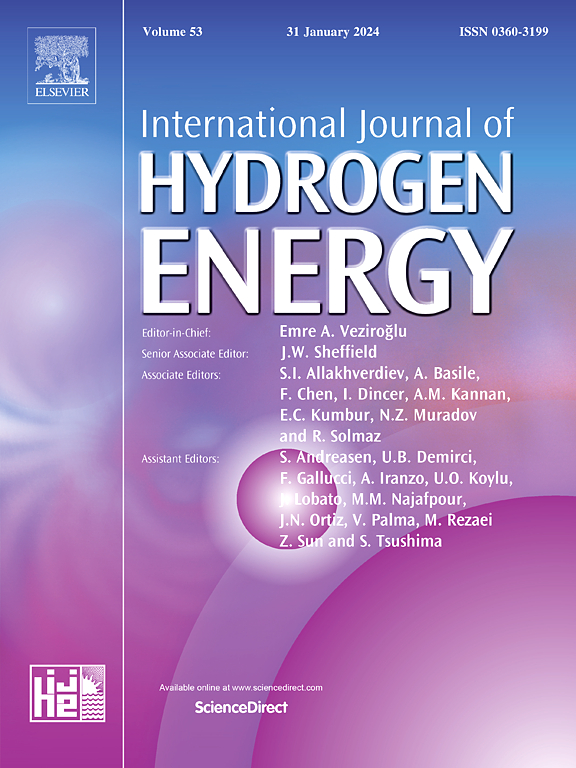Construction of W18O49/ZnTiO3 Z-Scheme heterojunction with rich oxygen vacancies and LSPR effect for enhanced photocatalytic H2 evolution
IF 8.3
2区 工程技术
Q1 CHEMISTRY, PHYSICAL
引用次数: 0
Abstract
Photocatalytic water splitting is widely regarded as a clean and sustainable approach for H2 evolution, offering great potential to address the energy crisis and reduce environmental pollution. However, the practical application of photocatalysts is hindered by low utilization of photogenerated carriers and rapid electron-hole recombination. To overcome these challenges, Z-scheme W18O49/ZnTiO3 heterojunctions nanoparticles are successfully synthesized via a solvothermal method and systematically investigated their photocatalytic performance for H2 evolution. Structural characterization reveals intimate interfacial contact and a stable Z-scheme electron transfer pathway between W18O49 and ZnTiO3. The abundant oxygen vacancies in W18O49 modulate the electronic structure and trigger a strong localized surface plasmon resonance (LSPR) effect, which significantly enhances visible and near-infrared light absorption. The LSPR effect generates hot electrons that can directly transfer to ZnTiO3, increasing the number of photogenerated electrons available for H2 evolution. Photoelectrochemical analysis confirms that the built-in electric field of the Z-scheme structure facilitates efficient charge separation and migration. Under simulated sunlight, the WZn-2 composite sample exhibits a high H2 evolution rate of 1.73 mmol g−1 h−1, outperforming the W18O49 and ZnTiO3 original sample. This not only provides new insights into the design of high-performance photocatalytic materials, but also offers potential applications in clean energy development and utilization.

富氧空位W18O49/ZnTiO3 Z-Scheme异质结的构建及LSPR效应增强光催化析氢
光催化水裂解被广泛认为是一种清洁和可持续的氢气生成方法,在解决能源危机和减少环境污染方面具有很大的潜力。然而,光生载流子利用率低、电子-空穴复合速度快等问题阻碍了光催化剂的实际应用。为了克服这些挑战,通过溶剂热法成功合成了Z-scheme W18O49/ZnTiO3异质结纳米颗粒,并系统地研究了其光催化H2的性能。结构表征表明W18O49与ZnTiO3之间存在密切的界面接触和稳定的Z-scheme电子转移途径。W18O49中丰富的氧空位调制了电子结构,引发了强烈的局域表面等离子体共振(LSPR)效应,显著增强了可见光和近红外光的吸收。LSPR效应产生的热电子可以直接转移到ZnTiO3上,增加了可用于H2演化的光生电子的数量。光电化学分析证实,z型结构的内置电场有助于有效的电荷分离和迁移。在模拟阳光下,WZn-2复合样品的H2析出速率高达1.73 mmol g−1 h−1,优于W18O49和ZnTiO3原始样品。这不仅为高性能光催化材料的设计提供了新的见解,而且在清洁能源开发利用方面具有潜在的应用前景。
本文章由计算机程序翻译,如有差异,请以英文原文为准。
求助全文
约1分钟内获得全文
求助全文
来源期刊

International Journal of Hydrogen Energy
工程技术-环境科学
CiteScore
13.50
自引率
25.00%
发文量
3502
审稿时长
60 days
期刊介绍:
The objective of the International Journal of Hydrogen Energy is to facilitate the exchange of new ideas, technological advancements, and research findings in the field of Hydrogen Energy among scientists and engineers worldwide. This journal showcases original research, both analytical and experimental, covering various aspects of Hydrogen Energy. These include production, storage, transmission, utilization, enabling technologies, environmental impact, economic considerations, and global perspectives on hydrogen and its carriers such as NH3, CH4, alcohols, etc.
The utilization aspect encompasses various methods such as thermochemical (combustion), photochemical, electrochemical (fuel cells), and nuclear conversion of hydrogen, hydrogen isotopes, and hydrogen carriers into thermal, mechanical, and electrical energies. The applications of these energies can be found in transportation (including aerospace), industrial, commercial, and residential sectors.
 求助内容:
求助内容: 应助结果提醒方式:
应助结果提醒方式:


